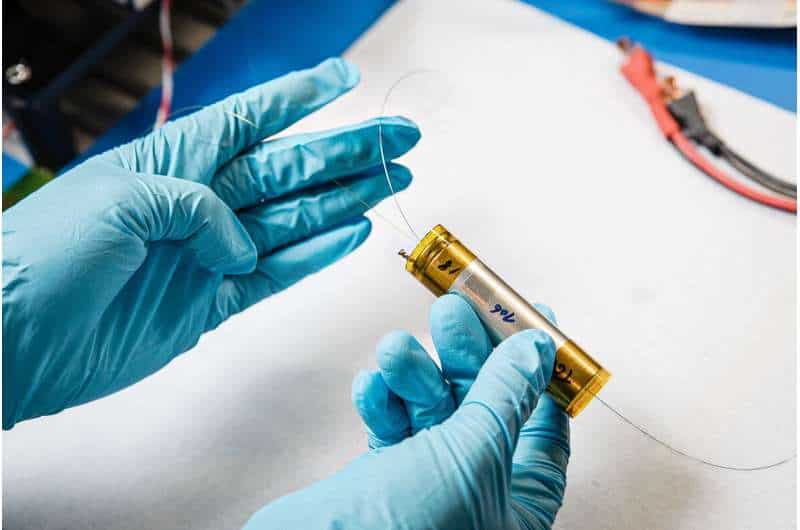To meet the growing global demand for electronics that can operate for long periods of time, engineers will need to develop highly performing and stable batteries with increasingly longer lifetimes. To reliably continue improving battery technologies, one should ideally be able to continuously monitor the dynamic chemistry inside their cells in real-world operating conditions, to identify potential issues and maximize their performance.
Researchers at Collège de France, Réseau sur le Stockage Electrochimique de l’Energie (RS2E) and Université de Rennes (CNRS) have recently devised a method to monitor the evolution of electrolytes inside Na- and Li-ion battery cells in real-time and under real working conditions. This method, introduced in Nature Energy, is based on the use of a measurement technique known as operando infrared fiber evanescent wave spectroscopy.
“Batteries are electrochemical devices that can store energy in chemical form,” Jean Marie Tarascon, one of the researchers who carried out the study, told TechXplore. “Parasitic reactions such as electrolyte degradation contribute to improving or degrading battery performance. It is therefore important to push the boundaries of operating techniques to monitor these complex chemical processes.”
In their previous research, Tarascon and his colleagues identified a strategy to measure both the temperature and pressure of battery cells under “normal” working conditions. This strategy consisted in inserting single-mode silica optical fibers inscribed with fiber Bragg grating (FBG) sensors (i.e., enabling the periodic modulation of the refractive index of the silica fiber over a short distance) into the batteries.
“Using this approach, we estimated the energy associated with the partial decomposition of the electrolyte and the formation of the solid–electrolyte interphase (SEI), an ion conductive and electron-insulating layer that forms on battery electrodes,” Tarascon explained. “However, we failed to determine the chemical species involved in the process, as the measurement is blind to the fiber’s chemical environment.”
The strategy to monitor the evolution of electrolytes inside cells introduced by Tarascon and his colleagues is based on the transmission of infrared light in chalcogenide glass optical fibers placed inside a battery. This infrared light interacts with the battery constituents, allowing researchers to identify and track the chemical molecules around the optical fibers.
“Using our method, we observed electrolytes evolution as well as the insertion/extraction of sodium-lithium ions in the electrodes according to the state of charge,” Tarascon said. “With this system, scientists were also able to prospect the interface between the electrolyte and the negative electrode material called the solid electrolyte interphase (SEI). This layer, which is both ion-conducting and electron-insulating, determines how long the batteries last.”
The method proposed by this team of researchers allows engineers to better understand the chemical processes occurring inside specific battery cells and how they evolve over time. In addition to observing the evolution of electrolytes (i.e., substances inside batteries that contain ions and can be decomposed by electrolysis), the strategy can be used to follow chemical species involved in the nucleation and growth of the SEI, which is formed during the first step of a battery’s charging.
“Currently, it takes a long time to optimize electrolytes and protocols to find the best option for an ideal SEI, and thus improve battery the longevity,” Tarascon said. “With our newly devised method, it is possible to quickly and accurately see how each element of the recipe evolves, interacts with others and influences battery performance.”
In the future, the new method introduced by this team of researchers could help to simplify and improve the design of battery technologies. Meanwhile, Tarascon and his colleagues plan to continue improving their measurement strategy and develop new ones that could be used to gather even more information about SEI layers.
“Aside from revealing chemical species involved in parasitic electrolyte degradation, our analytical approach provides insight into insertion processes and the Na(Li) inventory within the cell upon cycling,” Tarascon added.
“Moreover, the feasibility of monitoring processes such as SEI nucleation and growth over cycles, will aid in developing better aging models and, consequently, more advanced battery management systems. This operando technique could also be applied to other energy-storage devices (such as fuel cells and supercapacitors).”

